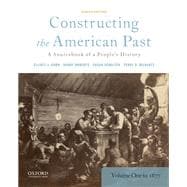The 8th edition of Constructing the American Past presents an innovative combination of case studies and primary source documents from the 15th to the 19th century for readers to discover what life was like in the past. These case studies and documents allow the reader to discover, analyze, and construct history from the actors' perspective.
Beginning with Christopher Columbus and his interaction with the Spanish crown in 1492, and ending in the Reconstruction era United States, Constructing the American Past provides eyewitness accounts of historical events, legal documents which helped shape the lives of citizens past, and excerpts from diaries which show history through an intimate perspective. The authors expand upon past scholarship and include new material regarding gender, race, and immigration in order to provide a more complete picture of the past.








